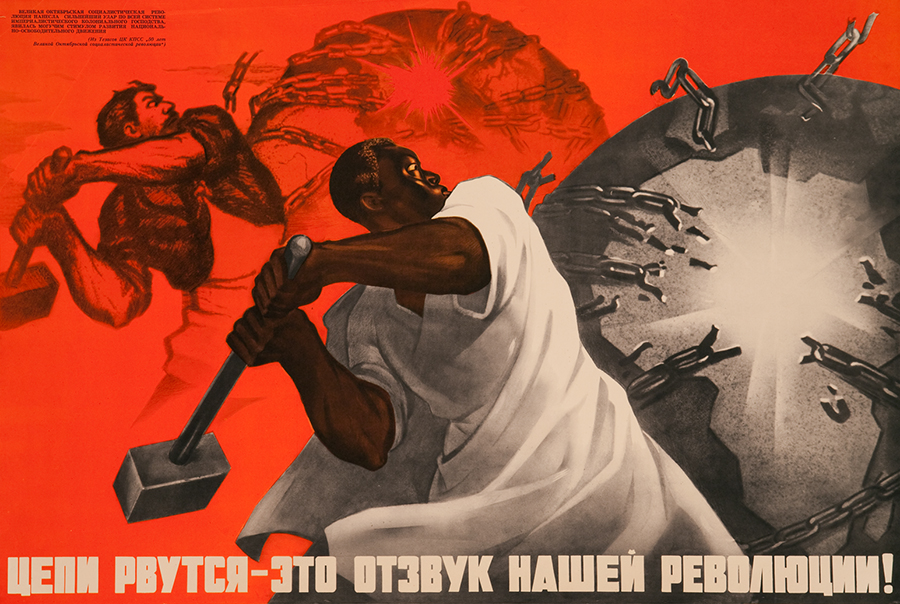
When I stepped into the South Gallery of the Ezra and Cecile Zilkha Gallery, I was greeted at the entrance by an imposing cloth banner that reached from floor to ceiling. The banner contained a black and white image of Wayland Rudd—the namesake of the new collection appearing at the Zilkha Gallery—performing at a theater in Moscow. Rudd is a figure whose personal story helps to inform the social context behind artist Yevgeniy Fiks’ “The Wayland Rudd Collection.”
Rudd, a stage actor, was born in Lincoln, Nebraska in 1900. He moved to the Soviet Union in 1932 to pursue a career in acting because he believed that he, as a Black man, would be free from the racial discrimination that plagued the United States. In the USSR, Rudd was a successful stage and film actor whose image was used as a model for many of the Soviet paintings, drawings, and propaganda posters that make up the gallery’s collection.
The graphics presented in“The Wayland Rudd Collection” are samples from an archive that features representations of Black people in Soviet-era print and media. Fiks began amassing these images over a decade ago. This traveling exhibition helps expound on the complex visual and rhetorical intersection between race, communism, and internationalism utilized by the USSR in the domestic and international geopolitical sphere and as a counterpoint to its capitalist and imperialist rival, the United States.
The images displayed range from 1925 to 1990 and uniformly depict a strong anti-racist and anti-colonial message, sometimes explicitly directed at the United States, but more often in general support of liberation movements in Africa. The images also display the internationalist ethos of Soviet communist politics. Prominent anti-colonial African leaders like Nelson Mandela and Patrice Lumumba are depicted in the posters and a recurring visual trope is of Black people breaking free from the chains of racism and colonialism.
A poster by Tymofi Lyashchuck depicts two hands, victoriously raised up to the sun with the remnants of broken chains. The text reads: “Liberated Africa is throwing off its chains.”
The pieces often utilize depictions of the violence and oppression of Black people as a tool for the USSR’s own geopolitical aspirations. These depictions feature the United States and are prominently displayed throughout the exhibition.
The poster “America’s Shame,” created by Viktor Koretsky in 1968, depicts an African American man lying dead with the New York skyline in the background, splattered with blood.
These images, and to a broader extent the USSR’s explicitly anti-racist rhetoric, directly impacted internal American politics. Foreign policy officials acknowledged that legally enshrined racism in the United States was harmful to its global standing. This opinion played a role in the Supreme Court’s 1954 ruling in Brown v. Board of Education, which outlawed the system of “separate but equal” in public education.
Perhaps most interesting are the smaller postcards, magazines, stamps, and envelopes which fill up the vitrines in the center of the gallery. While less eye-catching than the large posters that decorate the walls, these smaller images offer more glimpses into the daily lives of the citizens of various African countries.
“The images on display span the period from 1925 to 1990 and conjure up a strikingly uncompromising and consistent statement against racial oppression, which in time, contains racist undertones itself,” Assistant Professor of Russian, East European, and Eurasian Studies Roman Utkin stated in his remarks at the opening reception for the exhibition. “Taken together, these images present us with ideological tools for constructing both identity and otherness—a collage of internationalism, solidarity, humanist ideas, communism, exoticization, and hypocrisy.”
Does the complex geopolitical and domestic Soviet context detract in any way from this forceful anti-racist message and its impact around the world? In 2021, Fiks released a book that contained a collection of critical essays that analyze the intersection of race and communist internationalism displayed in the exhibition in such an impactful way. In the book’s introduction, he relays a story about an older African American man who came up to him after the presentation of “The Wayland Rudd Collection” in Harlem in 2013.
“It doesn’t matter who produced these images and how,” Fiks writes of what the man said to him.“It does not matter if the Soviets were hypocritical. And it does not matter if the artists who made these images were well paid. Good for them! These images were strong and dignified and when we saw them in the 1960s in Harlem they meant a lot to us. They meant a lot to us here.”
Yoni Semel can be reached at ysemel@wesleyan.edu.


Leave a Reply